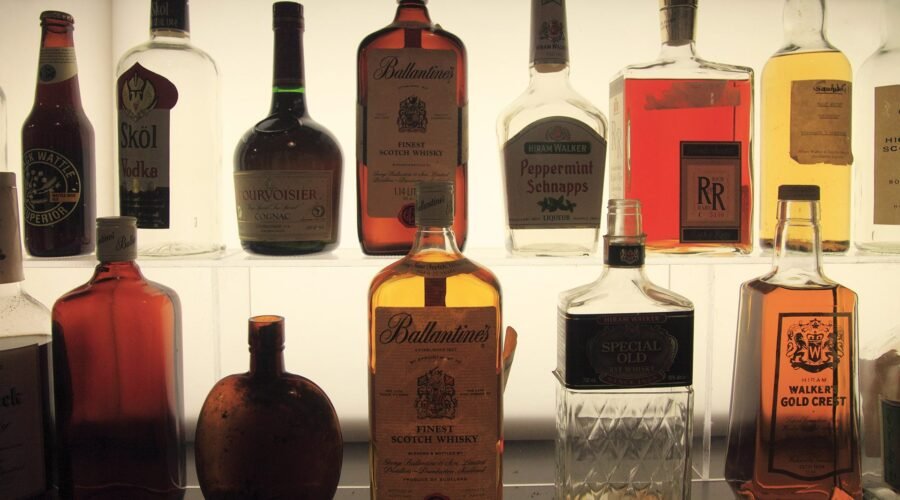Selling ‘Dusties’ Is Hard Work
Want to give you the liquor I found in cabinet, the text from my mother-in-law read. This is how I came to be in possession of four unopened, pristine-condition 1980s-era bottles: two blended Scotch whiskeys and two VSOP Cognacs. All four were good, mid-range bottlings when they were issued, not particularly rare or special. But considered vintage.
Though I had just turned in a story about the Sotheby’s auction of a rare Adami edition of The Macallan 1926—which sold for an eye-popping $2.7 million, I wasn’t delusional that I’d just acquired liquid gold. But hundreds of people make a hobby or a business out of chasing down antique bottles, often shorthanded as “dusties,” as they gather dust in homes or on liquor store shelves. Surely one of my bottles had value?
Buying dusties has become easier than ever, as specialists like London-based Old Spirits Company and auction houses source collectible bottles from around the world, and bars like Billy Sunday (Chicago, Charlotte) dole out individual pours of vintage amaro. But selling a bottle? Harder than I expected.
You May Also Like: The World’s Most Sought-After Scotch May Fetch $1.4 Million
I grabbed my detective hat and a copy of Dusty Booze, a new book by writer Aaron Goldfarb (Abrams Press, March 2024), about the adventures of so-called dusty hunters. The guidelines in the book (plus websites like Whiskey ID and deep dives into collector forums on Reddit), helped identify what I had.
Paper strips across the closures of two of the bottles were tax stamps, required by Bottled-in-Bond Act from 1897 through 1985. Parsing out the wording on the stamp, which changed every few years, narrowed my range to 1982 or later. So those bottles likely were 1982–1985. The remaining two bottles had no tax labels on the bottle neck, meaning they were likely post-1985. However, neither had a Surgeon General warning on the back, which became mandatory in 1989. So I assigned those a date range of 1986–1988.
Sleuthing turned out to be easier than selling. I approached a Facebook group dedicated to vintage Scotch. “Common,” sniffed one member about my Dewar’s White Label.
Meanwhile a newsletter from Old Liquors, a small purveyor of rare and antique spirits, landed in my inbox. It was an enticement to stock up for the holidays, but I tried my luck as a seller instead. Managing partner Bart Laming was mercifully blunt: “They are not rare and of low value, best to drink them.”
Finally, I aimed a Hail Mary at Skinner Auctioneers, which has a robust vintage spirits department. “Regrettably, the market hasn’t kept pace and we’re unable to accept them for consignment,” responded Louis Krieger, deputy director of fine wines & rare spirits at Bonhams Skinner.
The mission to sell the bottles had failed. Apparently vintage isn’t the same as valuable. Yet, I still had a pretty good consolation prize, Goldfarb assured.
You May Also Like: Five Tips to Finding Collectible Spirits
The blended Scotches in particular were likely pretty good, he explained, as they were assembled before the single-malt boom of the 1980s. Prior to the 1960s, most Scotches were blends; my vintage bottle likely contained older and higher-quality whiskies than a modern-day equivalent. “A lot of older blended Scotch is better than we know it today,” Goldfarb said. As for the rest: “I’d hang on to them, drink them, turn them into cocktails.”
And that’s exactly what I did. I cracked open the Chivas Regal 12-year-old, finding hints of leather, tobacco and peat smoke—a much drier pour than the usual bright honey-and-fruit notes. And as a final toast to the end of the adventure: a round of vintage Rob Roys.
This article originally appeared in the May 2024 of Wine Enthusiast magazine. Click here to subscribe today!
In the Shop
Sip with Elegance
Our selection of barware glasses and personalized sets are the perfect way to enjoy that special bottle and end your night on a good note.
Published: May 21, 2024
Like what you’re reading? Learn more about:


